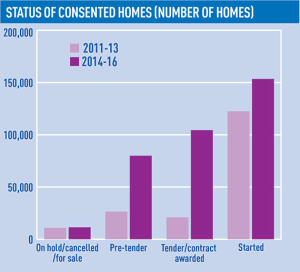 The number of sites with unimplemented planning permissions in England is a fifth of the amount claimed in some reports, according to analysis from Savills.
The number of sites with unimplemented planning permissions in England is a fifth of the amount claimed in some reports, according to analysis from Savills.
The agent said between 80,000 and 100,000 plots with planning permission in England are yet to be built, down from a claim from the Local Government Association in January that 476,000 were awaiting development.
Savills’ research found 532,000 plots with planning in England, 276,000 of which were under construction, while a further 233,000 were actively working towards it. Just 21,500 were on hold or stalled.
The speed of delivery of homes on sites with planning permission is dictated by market demand and absorption rates. The research estimated that larger sites deliver only 120 homes a year on average.
However, Savills said the delay caused by working through planning conditions was also a growing burden for developers and led to an average delay of nine months.
Of 107,000 schemes yet to agree a construction contract, 67% agreed planning only in the past year.
Rob Perrins, managing director of Berkeley Group, said: “Developers are eager to build, but it’s hard work getting land into production. It remains a slow, expensive, adversarial process.
“There is no mechanism to sort out quickly the complicated issues: compulsory purchase orders, rights to light, vacant possession and utilities, for example. It can take two years to start building on a major site once you have a signed section 106. That’s a real problem for us and for the market as a whole.”
The solution is to bring forward a more diverse range of sites through local plans, which would bring small and medium-sized developers back into the market, said Savills’ head of planning David Jackson.
“Local authorities seek to allocate the bulk of requirements through big sites, which then take a long time to deliver. At the moment there is not sufficient diversity to allow smaller regional housebuilders to come into the marketplace. We need to allocate a greater diversity.”
“The point about smaller sites is a strong one and anything that can bring back the small- and medium-sized housebuilder has to be encouraged,” said Michael Lowndes, executive director at Turley.
“The big developers need to manage the delivery of units into the market. Also they find there is more infrastructure and more remediation, all of which takes time. Complex permissions have complex conditions attached. Those can be an impediment to delivery.”
The research said that 86% of sites with planning permission in England are for more than 100 homes.
 However, the fault should not be laid entirely at the feet of authorities, which are expected to deliver increasingly complex planning decisions when budgets have been slashed.
However, the fault should not be laid entirely at the feet of authorities, which are expected to deliver increasingly complex planning decisions when budgets have been slashed.
“It’s complicated,” said Marnix Elsenaar, partner and head of planning at Addleshaw Goddard. “One of the things that makes the planning system slow is that people expect more and more of it, and add more and more layers of complexity. They are also expecting the planning system to be a tool of social policy.”
He added: “For local plans, it’s still a slow process. Too many authorities still do not have up-to-date plans, but that’s because the process is drawn out. They have to get an evidence base in place, they have to consult. There are stages to go through.”
In March the Local Plans Expert Group submitted a report to government, which aims to speed up and simplify the process through a variety of measures.
But according to Savills’ Jackson, there needs to be more strategic thinking from authorities. “Authorities allocate land to meet a number without asking what the strategies are for delivery. There needs to be more of a shared ownership between planning authorities and developers.”
Unimplemented permission in numbers
476,000 number of unimplemented permissions, according to the LGA
532,000 total England permissions
233,000 working through post planning (44%)
276,000 construction started (52%)
21,500 stalled (4%)
120 the average annual absorption rate of homes on big sites
9 months average delay between receiving planning and starting on site
Of the 233,000 plots working through post planning
107,000 have yet to appoint a contractor
67% gained permission in the past year
47,000 have yet to start work 12 months after permission granted
80,000-100,000 total number of stalled sites
• To send feedback, email alex.peace@estatesgazette.com or tweet @EGAlexPeace or @estatesgazette










